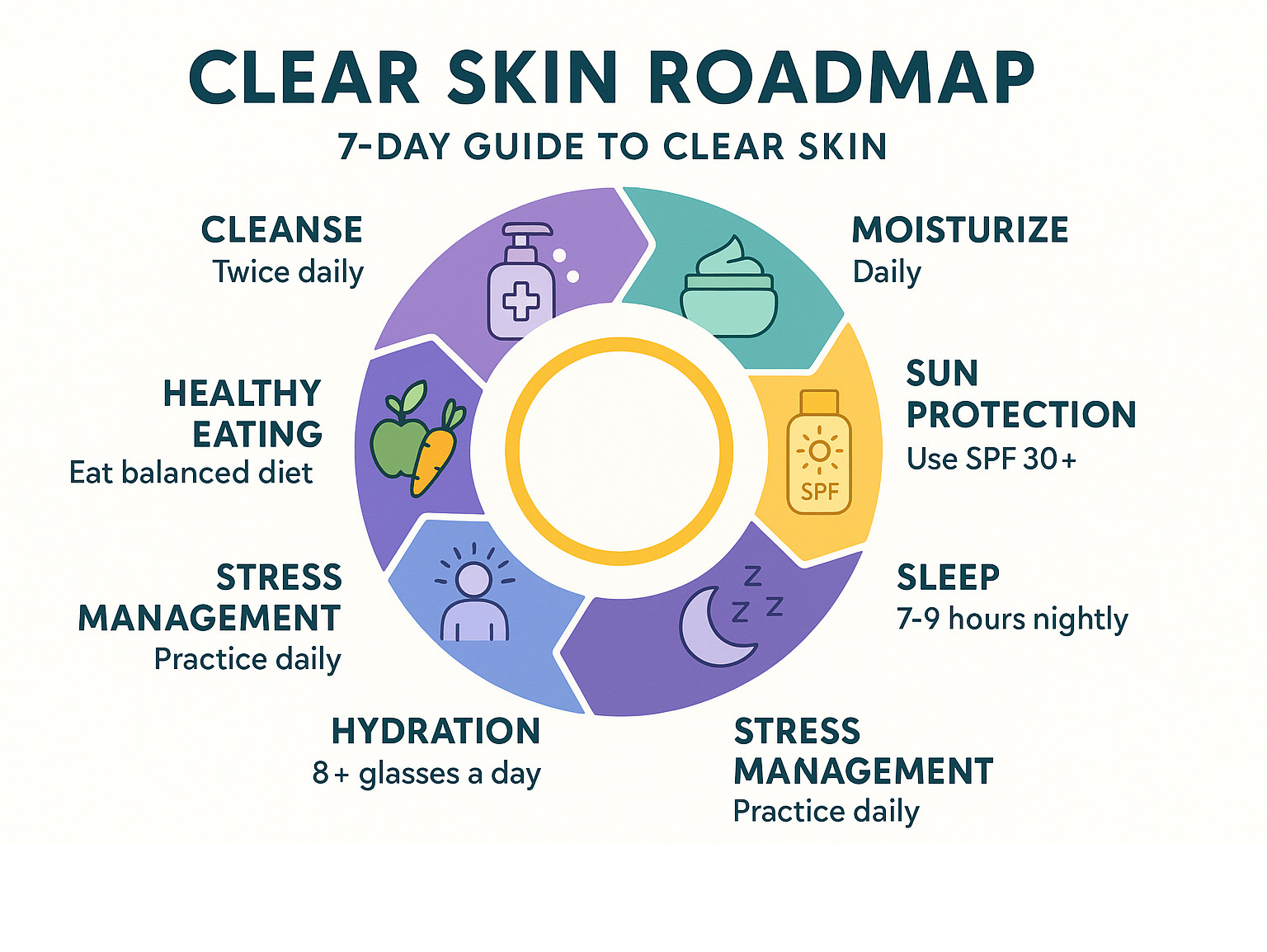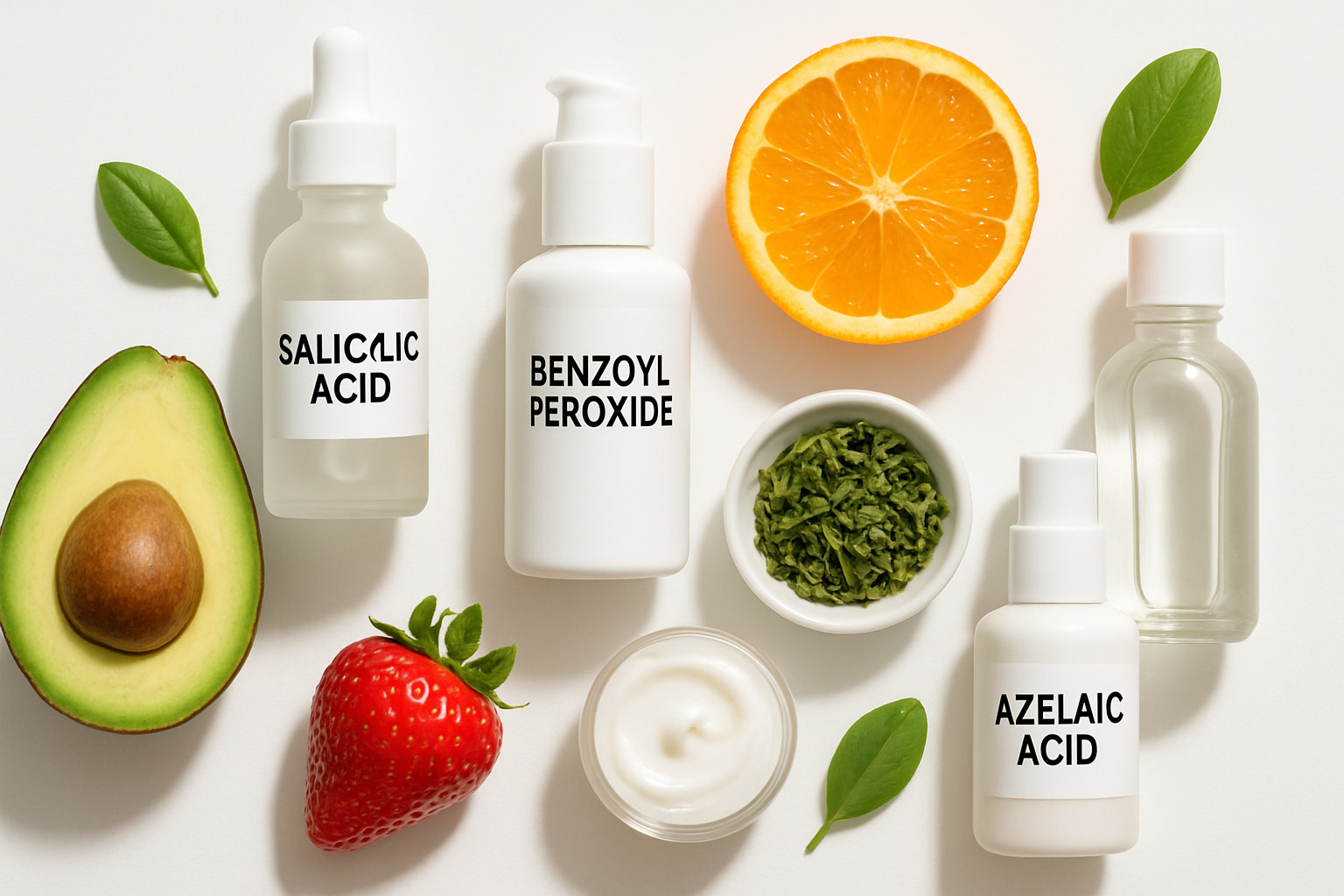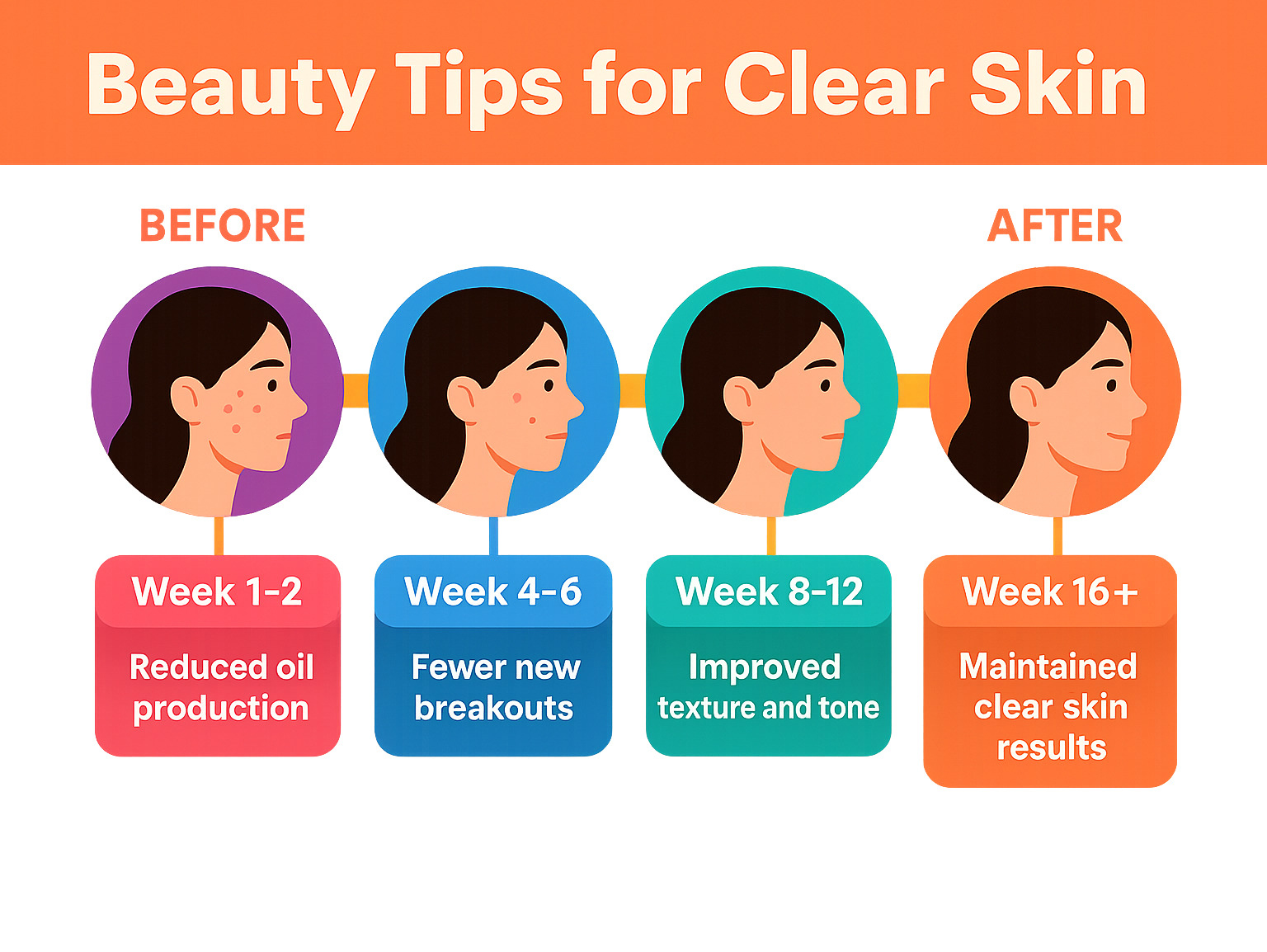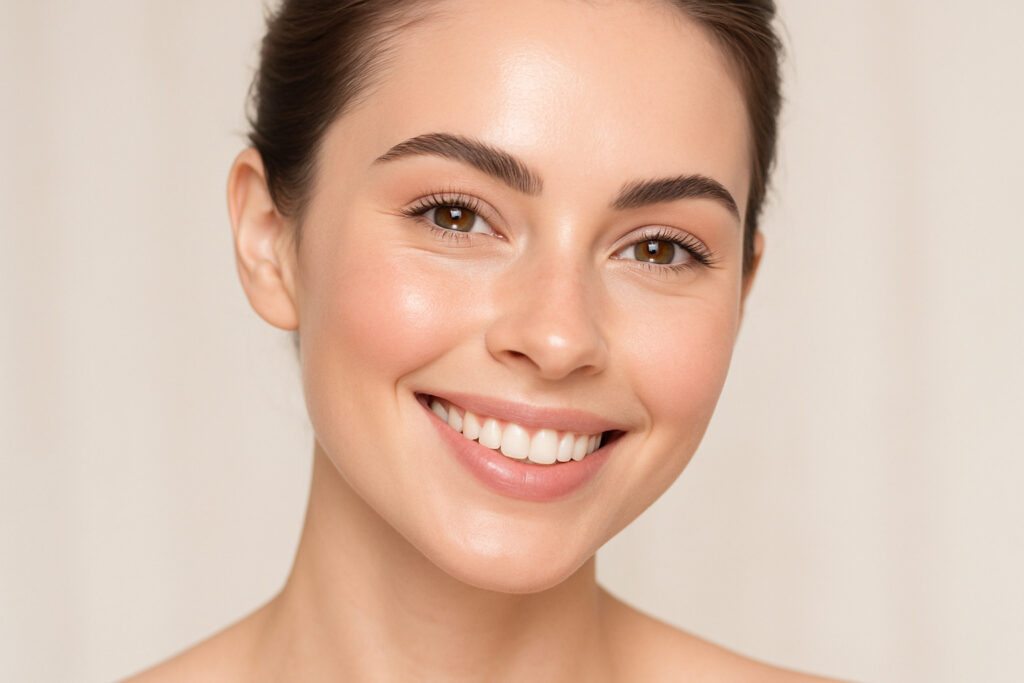Why Your Journey to Clear Skin Starts Today
Beauty tips for clear skin don’t have to be complicated or expensive. Sometimes it’s hard to know what your skin really needs amid marketing hype and social-media advice, but the research shows that simple, consistent habits deliver the best results.
Quick Clear Skin Essentials:
– Cleanse twice daily with a gentle, fragrance-free cleanser
– Moisturize daily with non-comedogenic products
– Apply SPF 30+ every morning, even indoors
– Get 7-9 hours of quality sleep nightly
– Stay hydrated with 8+ glasses of water daily
– Avoid touching your face throughout the day
– Change pillowcases every 2-3 days
Your skin protects everything inside your body from germs, dirt, and harsh weather conditions. But achieving that healthy, radiant glow doesn’t require a 12-step routine or products with unpronounceable ingredients.
The truth? Research shows that washing your face twice daily significantly improves acne lesions compared to washing only once a day. Meanwhile, 87% of people following a low-glycemic diet reported less acne, proving that clear skin starts from within.

Beauty tips for clear skin terms explained:
– Beauty and self-care
– Sustainable beauty products
– Beauty hacks for busy women
Why “clear skin” starts with healthy habits
Clear skin isn’t just about the absence of breakouts – it’s about healthy, balanced skin that looks and feels radiant. When we talk about achieving clear skin, we’re aiming for skin that’s free from active breakouts, has minimal blackheads or whiteheads, shows even tone and texture, and maintains proper hydration levels.
Setting realistic expectations is crucial. Most people see initial improvements within 4-6 weeks of consistent skincare habits, with more dramatic results appearing after 8-12 weeks.
Our approach at Beyond Beauty Lab emphasizes gentle, sustainable methods that work with your skin’s natural processes rather than against them.
Daily Habits That Deliver Clear Skin
Think of your daily skincare routine as a gentle conversation with your skin rather than a battle against it. The most effective beauty tips for clear skin aren’t about harsh treatments or expensive products – they’re about consistent, thoughtful habits that support your skin’s natural healing process.
Washing your face twice daily might seem obvious, but here’s what makes the difference: technique and temperature. Scientific research on face washing shows that people who cleanse morning and night have significantly fewer breakouts than once-a-day washers. Use lukewarm water, not hot. Hot water strips away your skin’s protective oils, which actually triggers your skin to produce more oil to compensate.
Switch to a silk pillowcase and wash pillowcases every 2-3 days. You’re pressing your face against that fabric for 7-9 hours each night, and oils, dead skin cells, and bacteria build up quickly.
Here’s a habit that’s trickier than it sounds: stop touching your face. We unconsciously touch our faces about 16 times per hour, transferring whatever’s on our hands directly to our skin.
Keep showers short – aim for 5 minutes or less with warm water. Long, steamy showers disrupt your skin’s moisture barrier and can make your skin produce more oil to compensate.
Morning routine in 3 minutes
Start by cleansing gently with lukewarm water and a mild cleanser. Splash your face, apply cleanser, massage for 30 seconds, then rinse thoroughly.
While your skin is still slightly damp, apply a lightweight moisturizer that won’t clog pores (look for “non-comedogenic” on the label).
SPF 30 or higher sunscreen is your non-negotiable final step. Yes, even if you’re staying indoors – window glass doesn’t block all UV rays.
Night routine that lets skin repair
If you wear makeup or sunscreen, start with double cleansing – use an oil-based cleanser first, then follow with your regular water-based cleanser.
Never sleep in makeup – this is one of the fastest ways to wake up with new breakouts.
Sleep hygiene matters more for your skin than you might realize. Aim for 7-9 hours nightly. Studies show that more than 65% of people who feel chronically tired also struggle with acne. Poor sleep increases cortisol, which triggers inflammation and can worsen existing breakouts.
Beauty Tips for Clear Skin: Skincare Routine Essentials
Building the right skincare routine feels overwhelming when you’re staring at endless product options, but it doesn’t have to be rocket science. The secret is understanding what your skin actually needs.
Your skin type matters more than trends. Oily skin produces excess sebum and tends to develop blackheads and breakouts. Dry skin often feels tight after cleansing and may show flaky patches. Combination skin is oily down the center but dry on the cheeks. Sensitive skin reacts to new products with redness, burning, or stinging.
Non-comedogenic products won’t clog your pores – crucial for moisturizers, sunscreens, and makeup you wear daily.
Always patch test new products before applying them all over your face. Apply a small amount to your inner wrist, then wait 24-48 hours to see how your skin reacts.
Key ingredients that work: Gentle cleansers without harsh sulfates clean without stripping. Vitamin C provides antioxidant protection while brightening. Retinol speeds up cell turnover and helps prevent clogged pores. Niacinamide controls oil production without drying. Hyaluronic acid delivers hydration without heaviness.
| Physical Exfoliation | Chemical Exfoliation |
|---|---|
| Uses scrubs, brushes, or textured cloths | Uses acids (AHA/BHA) to dissolve dead skin |
| Immediate visible results | Gradual, deeper results |
| Can cause micro-tears if too aggressive | Gentler on skin surface |
| Best for: Normal to oily skin | Best for: All skin types, especially sensitive |
| Frequency: 1-2 times weekly | Frequency: 2-3 times weekly |
Cleansing 101
Oil-free cleansers work wonders for oily and acne-prone skin because they remove excess sebum without adding more oil. Look for salicylic acid in your cleanser – this penetrates oil buildup and helps prevent clogged pores.
Avoid cleansers containing sodium lauryl sulfate (SLS), which strips your skin so thoroughly that it produces even more oil to compensate.
Acid toners deserve a spot in your routine 2-3 times per week. These gentle acids sweep away dead skin cells that can block pores. Start with once weekly applications.
For targeted strategies on breakout-prone skin, check out our detailed guide on Skincare for Acne-Prone Skin.
Exfoliation without irritation
Alpha hydroxy acids (AHAs) like glycolic and lactic acid work on your skin’s surface, dissolving the bonds that hold dead skin cells together.
Beta hydroxy acid (BHA), primarily salicylic acid, dives deep into pores to clear out oil and debris that leads to blackheads.
Start slow – once weekly is plenty when beginning. Over-exfoliation warning signs include increased redness, stinging, excessive dryness, or sudden increase in breakouts.
Moisturizing & barrier repair
Even oily skin desperately needs moisturizer. Skipping this step sends your skin into overdrive, producing even more oil to compensate.
Lightweight, gel-based formulas work beautifully for oily skin while dry skin types need richer creams with more substantial ingredients.
Apply moisturizer to slightly damp skin for maximum absorption. In winter or dry climates, switch to a heavier formula for extra barrier support.
Lifestyle & Diet Hacks for Flawless Complexion
Beauty tips for clear skin aren’t just about what you put on your face – they’re also about what you put in your body. Research shows that 87% of people following a low-glycemic diet experienced less acne, and 91% needed less acne medication.
Low-glycemic foods are your skin’s best friends. Think whole grains instead of white bread, sweet potatoes instead of regular fries, and fresh berries instead of candy. These foods don’t spike your blood sugar, which means they won’t trigger the hormone cascade that can lead to breakouts.
A 2018 review found a connection between milk consumption and acne development. Everyone’s skin is different, so pay attention to how your skin responds when you have more or less dairy.
Antioxidant-rich foods fight off free radicals that can damage your skin. Load up on colorful berries, dark leafy greens, and bright orange vegetables.
Omega-3 fatty acids from fish, walnuts, and flaxseeds help reduce inflammation throughout your body, including your skin.
Hydration is crucial. Men should aim for about 15.5 cups of fluids daily, while women need around 11.5 cups. Proper hydration helps your skin maintain elasticity and supports natural detox processes.
Stress management is essential – when stressed, your body pumps out cortisol, which increases oil production and inflammation. Even 10 minutes of daily meditation can help keep stress hormones in check.
Regular exercise improves circulation, bringing fresh oxygen and nutrients to skin cells while helping flush out toxins. Just shower promptly after working out.
If you’re a smoker: 73% of women who smoked had acne, compared to only 29.4% of non-smokers. Smoking also breaks down collagen and reduces blood flow to skin.
Quality sleep for 7-9 hours nightly is when your skin does its most important repair work. During deep sleep, your skin produces new cells and repairs daily damage.
For comprehensive sun protection information, check out this Scientific research on sun protection.
Hydration & nutrition checklist
Keep a reusable water bottle with you as a visual reminder to stay hydrated. Add lemon, cucumber, or mint for natural flavor.
The colorful plate approach makes nutrition simple: the more colors on your plate, the more diverse nutrients you’re getting. Aim for at least 5 servings of fruits and vegetables daily.
Green tea is packed with anti-inflammatory polyphenols. Try swapping one daily coffee for green tea.
Stress, sleep, and skin connection
When cortisol levels stay liftd due to chronic stress, your skin produces more oil and experiences more inflammation. Stress-reduction techniques don’t have to be complicated – find what works for you, whether it’s meditation, yoga, journaling, or physical activity.
Create a consistent bedtime routine by dimming lights an hour before bed, avoiding screens, and keeping your bedroom cool, dark, and quiet.
Smart Ingredient Guide & Product Picks

Understanding skincare ingredients doesn’t have to feel like reading a chemistry textbook. Think of it as learning the “language” your skin speaks.
Salicylic acid is like a tiny key that opens clogged pores. This BHA can penetrate through oil, making it effective for blackheads and whiteheads. Start with 0.5% concentration before moving to stronger formulas.
Benzoyl peroxide kills acne-causing bacteria but can be aggressive. Start with 2.5% strength rather than 10% – research shows lower concentrations can be just as effective with less irritation. Remember it makes your skin more sun-sensitive.
Azelaic acid is gentler – it fights bacteria, reduces inflammation, and helps fade dark spots from previous breakouts. It’s well-tolerated even by sensitive skin.
Clay masks (kaolin and bentonite) pull excess oil from pores. Use 1-2 times weekly for 10-15 minutes.
Tea tree oil fights bacteria naturally but needs to be diluted to 5% or less to avoid irritation.
Aloe vera gel soothes inflammation and plays well with other active ingredients.
For sunscreen, choose broad-spectrum SPF 30 or higher. Sensitive skin should look for zinc oxide or titanium dioxide. For lighter textures, chemical sunscreens with avobenzone and octinoxate work well.
When to level up to actives
Retinoids are the gold standard for preventing clogged pores and improving skin texture, but they require patience. Start with over-the-counter retinol products 1-2 times weekly, gradually increasing frequency.
Vitamin C serums provide morning antioxidant protection while helping fade dark spots. Use under sunscreen for maximum benefit. Start with 10% L-ascorbic acid or gentler forms like magnesium ascorbyl phosphate.
The golden rule: one new active at a time. Wait 2-4 weeks to see how your skin responds before introducing another.
Natural spot-treatments that work
Raw honey has antimicrobial properties that calm breakouts. Apply to clean skin for 10-15 minutes, then rinse.
Turmeric paste reduces inflammation in stubborn spots. Test first as it can temporarily stain light skin yellow.
For painful under-the-skin bumps, ice therapy provides immediate relief. Wrap ice in cloth and apply for 1-2 minutes. Never put ice directly on skin.
Common Mistakes Sabotaging Your Beauty Tips for Clear Skin
Over-scrubbing is one of the biggest mistakes people make. When you’re aggressive with exfoliants or harsh washcloths, you damage your skin’s protective barrier and create more inflammation. Your skin responds by producing even more oil, creating a frustrating cycle.
Products containing harsh alcohols like denatured alcohol feel refreshing but strip away your skin’s natural protective oils, triggering oil glands to work overtime.
Pore-clogging makeup and hair products can sabotage progress. Check labels for “non-comedogenic” on anything that touches your face, including hair styling products.
Sleeping in makeup is the fastest way to undo your hard work. Even one night can clog pores and lead to breakouts that take weeks to heal.
DIY treatments from the internet can harm your skin. Lemon juice is too acidic, baking soda disrupts pH balance, and undiluted essential oils can cause burns. Stick to properly formulated products.
Popping pimples almost always makes things worse. You risk pushing bacteria deeper, spreading infection, and creating permanent scarring.
For detailed guidance on product application order, check out our guide on How to Layer Serums and Moisturizers Correctly.
Makeup hygiene rules
Wash makeup brushes weekly using gentle shampoo – dirty brushes are bacteria farms. Replace beauty sponges after each use or wash thoroughly if reusable.
Expiration dates matter for skin health. Mascara should be tossed every three months, liquid foundations every 6-12 months, and powder products can last up to two years.
Resist sharing makeup with friends, especially eye and lip products. Sharing makeup spreads bacteria and infections between people.
Frequently Asked Questions about Beauty Tips for Clear Skin
How quickly can diet changes clear my skin?
Most people start noticing improvements around the 4-6 week mark after making consistent dietary changes. Full benefits typically unfold over 8-12 weeks.
Your skin cells renew approximately every 28 days, so the skin you see today reflects what you were eating about a month ago. The magic word is consistency – your skin responds to sustained patterns, not occasional healthy choices.
Consider keeping a food and skin diary. Common trigger foods include dairy products, processed foods high in trans fats, and anything that spikes blood sugar quickly.
Is sunscreen necessary indoors?
Yes, sunscreen matters indoors too! UV rays can penetrate through windows, especially if you’re working near bright windows or spending time in sunrooms.
Broad-spectrum SPF 30 is perfect for daily indoor use. If you’re stationed near windows for hours, consider reapplying midday.
If you spend most of your day in a windowless office under fluorescent lights, you could probably skip it, but most dermatologists recommend making it part of your daily routine regardless.
When should I see a dermatologist?
Schedule an appointment if your acne involves deep, painful cysts that feel like they’re brewing under the surface.
If you’ve been following a good skincare routine for 8-12 weeks without improvement, it’s time for expert evaluation.
Scarring is a red flag – once your skin starts forming permanent marks, over-the-counter treatments usually aren’t strong enough.
Don’t underestimate emotional impact. If skin concerns are affecting your confidence or daily happiness, that’s a valid reason to seek professional help.
Early intervention usually leads to better outcomes and can prevent scarring entirely.
Conclusion

The journey to clear, healthy skin doesn’t require expensive miracle products or complicated routines. What it does require is consistency with gentle, proven methods. Simple habits like washing your face twice daily, using non-comedogenic moisturizers, applying daily sunscreen, and getting quality sleep create the foundation for radiant skin.
The research speaks for itself. People who follow consistent skincare routines see significant improvements within 4-6 weeks, with even better results after 8-12 weeks of dedication. Beauty tips for clear skin work best when they stop feeling like tips and start feeling like natural parts of your daily life.
Think about it this way: you’re not just caring for your skin, you’re caring for yourself. Every time you choose lukewarm water over hot, hydration over sugary drinks, or sleep over late-night scrolling, you’re investing in your overall well-being.
Progress isn’t always linear, and that’s perfectly okay. Some mornings you’ll love what you see in the mirror. Other days, you might notice a new breakout and feel frustrated. Both experiences are normal. The key is celebrating small victories – maybe your skin feels softer, or you haven’t had a major breakout in weeks.
Stress management, proper nutrition, and gentle skincare work together as a team. You can’t out-moisturize a poor diet, and you can’t out-supplement chronic stress. But when you approach clear skin as part of overall wellness, everything starts working in harmony.
For those ready to dive deeper into achieving that natural glow, our comprehensive guide on Beauty Tips for Clear and Glowing Skin offers additional strategies and insights – courtesy of Beyond Beauty Lab.
At Beyond Beauty Lab, we believe that true beauty comes from understanding your skin’s unique needs and treating it with the kindness it deserves. Your clear skin journey starts with the very next choice you make. Whether that’s drinking an extra glass of water right now, planning to change your pillowcase tonight, or simply promising to be more gentle during tomorrow morning’s cleanse – every small step matters.
You already have everything you need to succeed. The path is clear, the methods are proven, and your future self is already thanking you for starting today.








